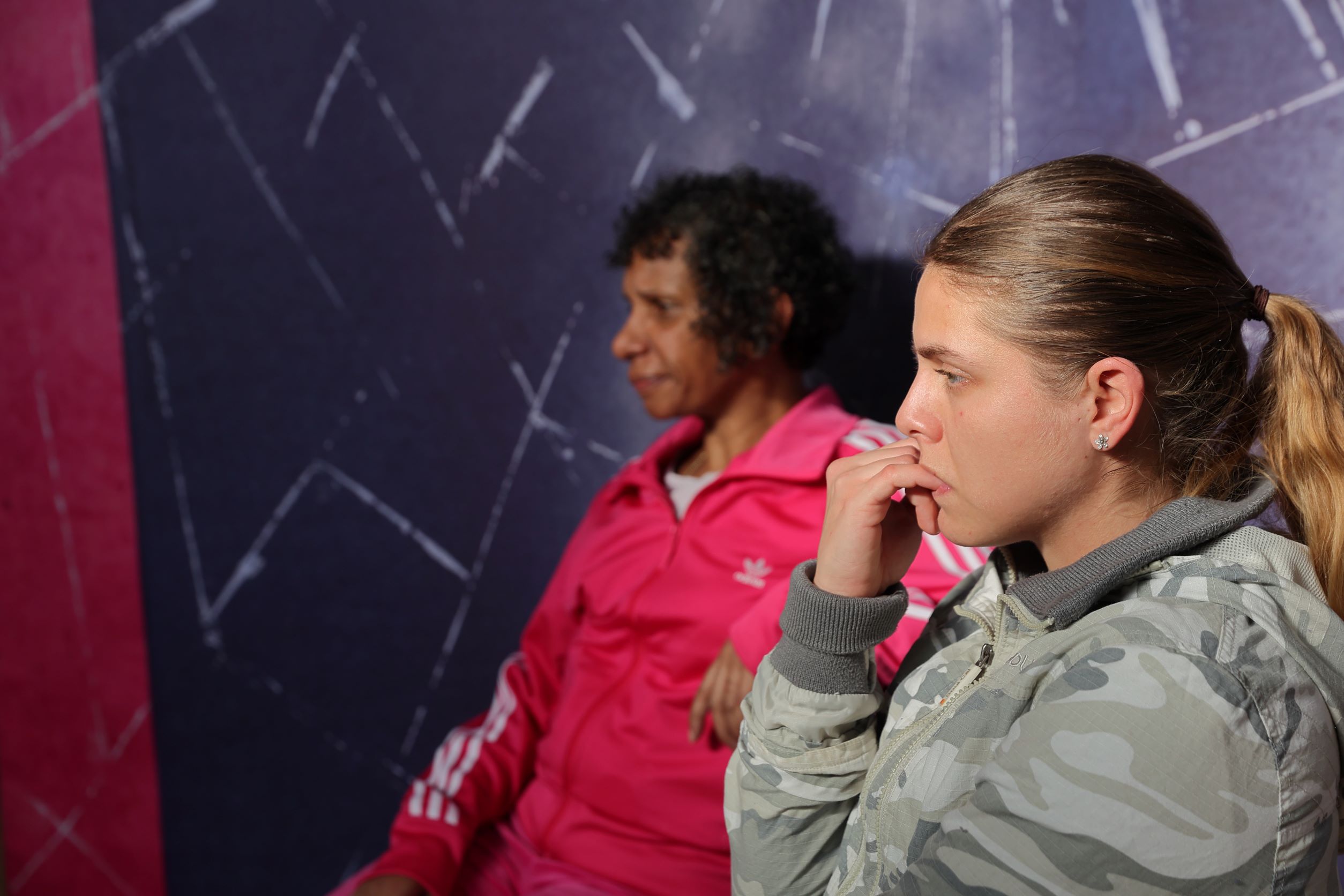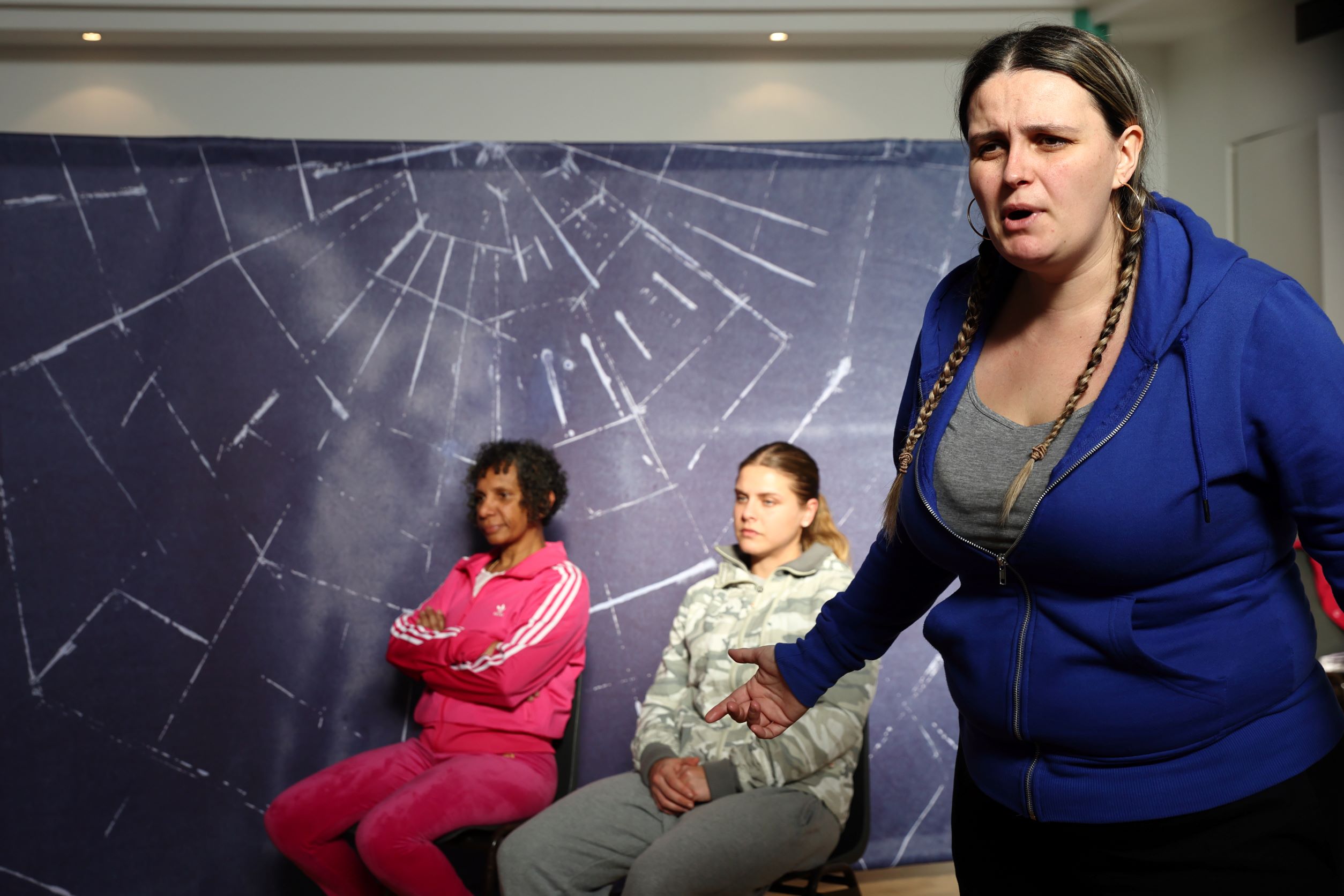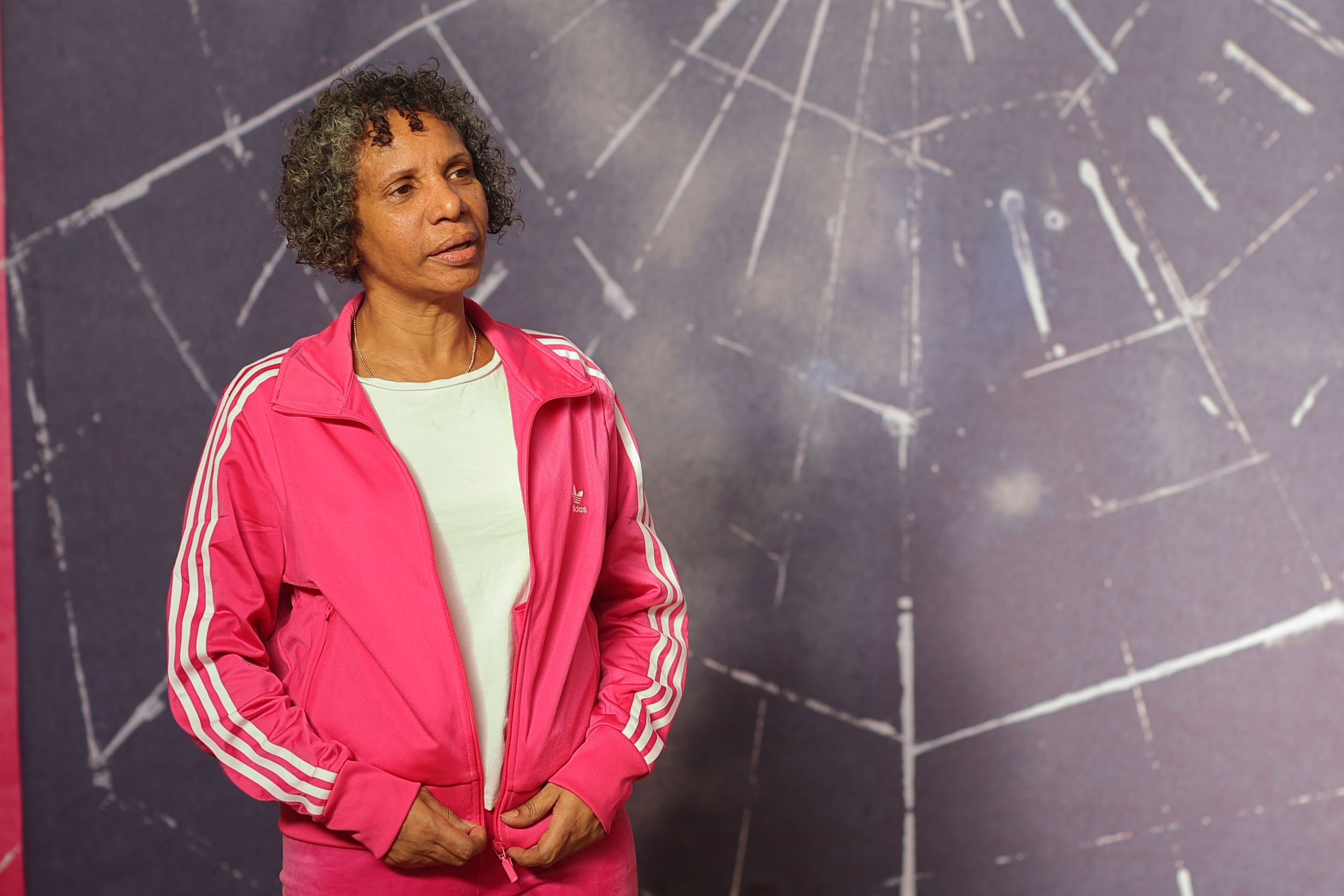
A conversation with the cast and director of our play Catch and Women in Prison's CEO
Catch, written by Sonya Jalaly, is a small-scale play which is designed to be performed in educational and professional settings, in order to open up conversations around women and criminalisation in a creative and accessible way.
Women in Prison's CEO Sonya Ruparel had an insightful conversation with the cast and Anna Herrmann, director of Catch and Clean Break’s Artistic Director, about how the story resonates with Women in Prison’s work.
Catch is performed by Daisy Bartle, Amy-Jane Pearce and Ann Whitely, who are Clean Break Members and are participating in our Actors Traineeship.
Catch was co-commissioned and developed through research with women service users and staff at the charity Advance.
Anna: Sonya, thank you for hearing a read through of Catch. Will you tell us about Women in Prison and your campaign on the value of women's centres?
Sonya: The play was amazing, thank you so much.
Women in Prison is now 40 years old. We were set up by an academic called Pat Carlen and a woman called Chris Tchaikovsky who experienced prison and the harm it was causing women, so when she came out of prison she thought, ‘This has to stop’.
We are a campaigning organisation, and we have services for women. We have women’s centres, outreach in the community, diversion work, through the gate work and we work across women’s prisons. We use that experience to campaign for change and ultimately, to see the end of women's prisons. However, while prisons are here, and while we are working within a system that's broken and harmful, we want to see it do less harm.
Anna: Why are women's centres important?
S: Having somewhere safe for women to go is so important and that really comes through in Catch, somewhere that women can feel supported by other women who understand the situations that they’re in, where they can talk - because having experience of the criminal justice system is so stigmatising, and so difficult for people to talk to families and friends about.
Anna: Of course, and even in that safe space there can still be shame and stigma and a lack of trust. All the characters in Catch struggle with talking about their circumstances, not wanting to bother people, not wanting to be labelled or judged.
S: It’s so true. I think the good thing about the women's centres is building relationships with the key workers. The narrative about the key worker Loretta in the play was interesting, she’s both loved and hated, but also slightly feared like, ‘Why is she being nice to me? I don't deserve that.’
What I also really loved about it was the peer support from the women, because I think that that gets overlooked - so much of the support can come from each other.

Anna: Do you feel like the three character’s stories resonate with the stories of women who use your centres?
S: Yes, so strongly. I think that domestic abuse and violence, and issues with housing and problematic use of alcohol are so prevalent. When I've spoken to women, their stories of substance use are often caused by trying to escape from violence. That’s why I got so emotional.
Anna: For the three cast members, as you're developing and understanding your characters, how do you think the women's centre impacts on their outcomes?
Amy-Jane: For my character Rachel, because of the women's centre she was able to be moved away from a bad situation: coming from care, being put into a hostel around men who have taken advantage of her. She was given the option to move to somewhere safer, if the women's centre hadn’t been there it could have been a lot worse for her.
Anna: And her relationship with Susan, another women using the centre, that’s important isn’t it?
A-J: Yeah, having that relationship with Susan, she encourages her to speak up and speak out.
S: With the character Christina, what really struck me was the unjust criminalisation of women. The only safety she had at the end was going back to prison, which is so awful, and that’s the system we are in. Criminalising women who have already been punished is the wrong answer.
Ann: For my character Susan, she's had her ups and downs but the centre is one staple in her life. She knows she can always go there and get the support, but why does it have to get to that?
S: Often, I ask women when I meet them, ‘What might have supported you, to not have got here?’ Very often it's mental health support, or domestic violence support and being listened to much earlier.
Often when women get arrested, the police never ask, ‘Why?’ There's no understanding of the trauma that has informed the event. Women are not supported with that trauma, and then they are sent to prison. As we know prison then causes more harm. Women can come out with a lack of confidence because they haven't been able to make their own decisions and feel stigma and shame from being in prison.
Anna: Even pre-sentence reports can be really poor, or non-existent, because of what's happened to the legal aid system. All the things that you would expect to help create a better outcome are broken.
In 2007, after a sequence of women’s self-inflicted deaths in prison, there was a report by Baroness Corston, who is a Labour peer. She went into prison, spoke to lots of women in contact with the justice system, and in her seminal report recommended the expansion of ‘Women’s Community Centres.’ This was a watershed moment for women’s centres and it was from then that the network of women’s organisations providing these services have expanded and developed.
Ann: So it’s an alternative? Instead of taking you to prison, you're going to go to the women's centre?
Sonya: Yes, women’s centres can help ensure women can be diverted away from the justice system, but we need much more focus on diversion, which is something I want Women in Prison to do more of.
It's about where the investment is, which is why our report argues that an investment in women's centres is going to save a huge amount of money, not just from the Ministry of Justice, but across the whole social services and local authorities. If you invest in the right support for women and the prevention side and the diversion side, it's going to save money in the long run.

Ann: In the 40 years since the foundation of Women in Prison, have things improved?
S: I think recently it seems to have got worse because we've seen a more punitive approach to women. People are being criminalised more, and whilst there's just over 3000 women currently in prison, the number who are being criminalised is much higher than that, for example with community sentences. The impact on society, including women’s families, is extraordinary, and at the moment because of the cost-of-living crisis, we know more and more people in poverty are going to be criminalised.
A-J: What’s the plan for the future?
Sonya: I think there needs to be a broader campaign to change people’s mindsets. Until that changes all you're doing is tinkering around the edges and hoping you’re having as much impact as you can with individual women. There needs to be radical change in how people view women and prison, and how people view prison itself because it is so harmful.
A-J: Could I give a suggestion? More places like Clean Break for women to go to when they come out of prison, or to prevent them from going to prison. Personally, my own experience being a Clean Break Member steadied me and grounded me. I feel as though I could have gotten into a situation where I would have been put in prison myself, but coming to Clean Break, it cleared my mind and made me see a better future without feeling unsafe.
It's really hard to have trust in people if you've been through certain things. But at Clean Break it’s about building up, but not in your face, it's behind the scenes and gradually, you get there.
Sonya: It's allowing women choices and giving options and opportunities, isn't it? Not just going ‘Oh, poor you!’
Anna: Who do you think should see Catch?
Sonya: I think it should be seen by government, the Ministry of Justice, the Department of Work and Pensions, the Home Office, that would be amazing.
Ann: Money and power, innit!
Sonya: It is! They might know some of the stories, but they might not have seen the impact.
Also local authorities, I think that’s where it needs to go, as in some cases they are funding women's centres. But we know women’s centres aren’t sustainably funded and that's the point of our report - women’s centres should be properly funded and there should be an understanding of their impact.
What's so beautiful about showing the play is that it shows the reality of a person. A report has lots of numbers and statistics, and for some people, that’s what you need, but theatre makes it real. I think people will relate to it and see how important it is to have peer support, and whilst I want to keep promoting women's centres, I also want to promote that anyone in the community can build peer support - what we need to do is tackle stigma. I think the play starts that conversation, and you don't have to come to a women's centre to have a conversation.

Anna: Do you feel like the play would be useful for women who have lived experience of the criminal justice system?
Sonya: I don't have that lived experience so I don’t want to talk on behalf of people, but I think it will be really helpful for staff at organisations, because often people are saying what they think workers want to hear. What was beautiful about that internal dialogue is you're hearing women just go, ‘Oh, f- off!’, because really inside they’re breaking.
Daisy: I think women with lived experience would be a great audience, but I wouldn't want to trigger people and bring up a lot of heavy stuff. Some women might find it helpful but some women might not.
Ann: I think everyone should hear it to be honest. I think women with lived experience would benefit from it, and there should be a trigger warning so that it's done with care.
A-J: What about youth centres? Young teenage girls can't just turn up at women's centres, but they look up to 18- and 19-year-old girls. Rachel who is 19 herself, the women's centre has given her that outlook that it's OK to speak to someone. You know, some teenage girls don't know who to talk to or where to turn to.
D: At that age, they think they know what they're doing, and it always ends up badly. Thinking it’s all lovey dovey, they're always old enough and always strong enough. And that's the problem, we ain't got people guiding us at that age.
A-J: Doing the play at youth centres, they could pick up on Rachel being able to speak up so they could take that in and think, ‘Oh actually it's OK to talk.’
D: Yes, because that don't always happen. People like Rachel don't always talk to people like Susan. They keep it inside until it's too far gone and then they end up doing things that they can't come back from, and then they've got a sentence.
A-J: There's a lot of youth centres that have been shut down, aren’t there.
D: And it's the funding again. So when you say the prevention side of it, there's so many things before that, that need to be sorted out.
It needs to start from a young age, kids need to know that there's places to go and there's not just: ‘Oh, I’ve got to go to uni.’ Some people don't think they're cut out for that, and that's what sends them on a wrong path and makes them believe they're not good enough.
They need places where they can feel worthy, achieving little things makes your mindset completely different. There's so many things that need to be sorted by the government.
Anna: That leads to my last question, what more could women’s centres do, that they're not able to do with their current funding?
Sonya: I can only speak for our women’s centres, because everyone's model is slightly different, but for me it's the prevention side. I would love to be doing much more on prevention, and really making sure there are mental health, drug and alcohol misuse and housing services within the centres. We don't have the funding to do enough of that.
It's also about reaching more women through accessing communities where, say if someone’s mum, or auntie or a friend goes to the women's centre and it feels safe to her, then that might work for some other younger people too.
We don't have many Asian women coming to our women's centres and that's interesting, right? If all your information and advice comes from your community, unless the services can access your community, you're never gonna get to that women's centre. So, how do we find the communities to start to build trust? Once you start, it will continue. Young women look to their role models.
Anna: It's a long haul, bit by bit, day by day, play by play for us, making a difference.
Women in Prison commissioned Catch to tour a number of women’s centres and prisons, which was performed for staff at both alongside an accompanying workshop.
Photography by Tracey Anderson.